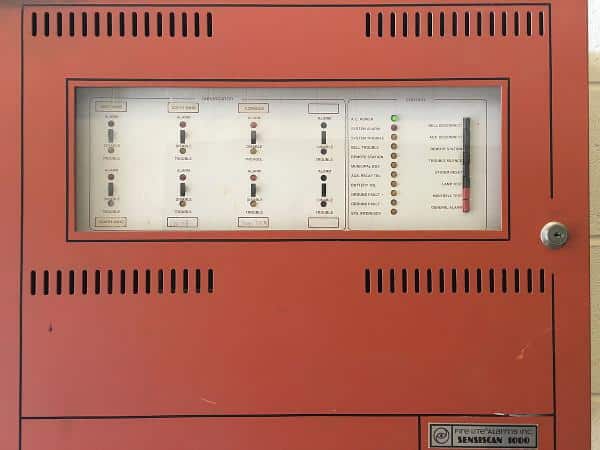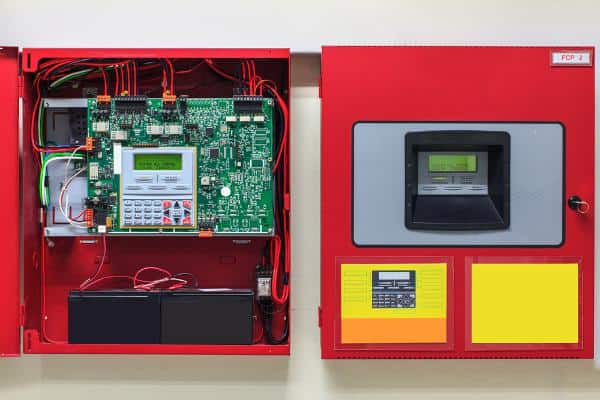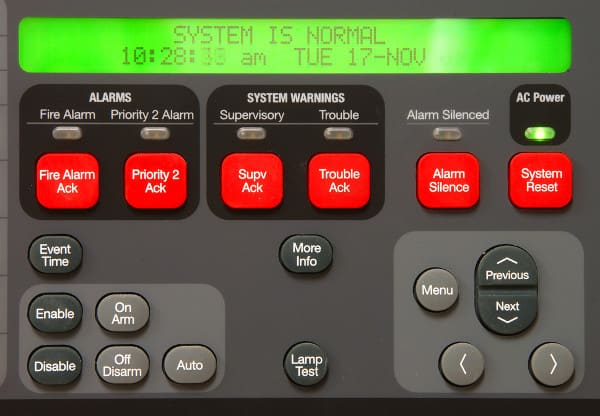The design, features, and code requirements of addressable and conventional fire alarm control panels
Known as a fire alarm control panel (FACP), fire alarm control unit (FACU), or fire panel, these appliances choreograph the activities of countless life-saving appliances to facilitate safe evacuation and swift emergency response during a fire. In this article, we’ll take a look at how a fire alarm control panel features in a complete fire alarm system, what’s required by the International Building Code (IBC) and the National Fire Protection Association (NFPA), and what these standards mean for choosing a fire panel.
If you’re simply looking to buy monitoring and notifying devices compatible with fire alarm control panels, check out our line of fire alarm bells and accessories, and our electronic switches, such as tamper switches, flow switches, and alarm pressure switches, for fire sprinkler systems.
What does a fire alarm control panel do?
Fire alarm control panels perform a wide range of life-saving and property-protecting tasks. Some activate fire suppression or fire sprinkler systems, while others don’t. Some transmit a signal used to alert first responders, while others simply sound alarms in or around the building. Every fire panel acts as a middleman between devices that watch for hazards and devices tasked with alerting people to danger or problems with fire protection systems.
Here’s how that works: when a fire starts, a smoke detector, heat detector, hand-activated pull switch, or manual call point sends a signal to a fire panel. Fire sprinkler systems equipped with a flow switch or alarm pressure switch – devices designed to detect sprinkler activation – can also transmit a signal to the panel when water begins to flow through an activated sprinkler system.
The fire alarm control panel responds to any of these signals by lighting up or making noise, activating local bells or other signals, and/or sending a signal to fire officials or a private monitoring company tasked with notifying the authorities.
Many of these panels aren’t equipped to activate or send water to fire sprinkler heads, which usually activate one by one in response to rising ambient temperatures. However, panels installed with some deluge sprinkler systems, for example, can open or close a deluge valve, which allows fire suppressant to be distributed to many sprinkler heads simultaneously. Panels for fire alarm systems in some facilities go even further, locking or unlocking doors, disabling elevators, turning off the electricity, or shutting off or turning on ventilation.
Fire panels can also be integrated with building management systems and security systems. In these cases, the functions of a fire panel take priority over the other systems and “the other systems cannot interfere with the operation of the fire alarm.” For example, if an access control system locks down certain outer doors in a building due to an external security threat, that command would need to be overridden in the event of a fire evacuation. The below video shows doors and horizontal fire shutters that close automatically in a fire emergency; in this case, access control and fire safety systems should be integrated:
Fire alarm control panels may connect many devices, and addressable panels are designed to manage them
In NFPA 72: National Fire Alarm and Signaling Code, the National Fire Protection Association provides a broad definition of these devices, known in this code as a fire alarm control unit (FACU).
From the 2016 edition of NFPA 72
3.3.100* Fire Alarm Control Unit (FACU). A component of the fire alarm system, provided with primary and secondary power sources, which receives signals from initiating devices or other fire alarm control units, and processes these signals to determine part or all of the required fire alarm system output function(s). (SIG-PRO)
A.3.3.100 Fire Alarm Control Unit (FACU). In addition to the functions identified in the definition, a fire alarm control unit might have an integral operator interface, supply power to detection devices, notification appliances, transponder(s), or off-premises transmitter(s) or any combination of these. The control unit might also provide transfer of condition to relay or devices connected to the control unit. There can be multiple fire alarm control units in a fire alarm system.
These fire alarm control units are, like fire alarm systems, often classified in the fire protection industry as either “conventional” or “addressable.”
Conventional panels represent a building as a series of regions known as detection zones. When a smoke detector or pull switch in a zone activates, the electrical current to the fire alarm panel changes, and the control panel indicates that a device somewhere in that zone has been activated.

Devices connected to an addressable panel send data to the panel – rather than notifying via a change in electrical current – and display which specific device has activated. Each device has a unique “address” in the system, hence the name “addressable” panel. That additional level of detail allows personnel and first responders to more quickly identify exactly where the fire is and take appropriate action.
In this video, Lee Kaiser, Vice President of Engineering, Business Applications and Training for ORR Protection, a national fire protection contractor, summarizes key differences between conventional and addressable fire alarm systems.
Most panels can conduct drills, silence some notifications, and share other design features
To reduce the frequency of false alarms, fire alarm control panels feature pre-alarm indicators. These light up when activated by a monitoring device, giving personnel the chance to investigate the area before alarms sound. Silencers can allow emergency personnel or fire equipment installers to carry out their work without constant noise. Panels may also allow for conducting drills, monitoring for broken or malfunctioning devices, and resetting the system after an incident.
NFPA 72 specifies general operating requirements for all equipment used in fire alarm systems, including fire alarm control units:
From the 2016 edition of NFPA 72
10.3 Equipment.
10.3.1 Equipment constructed and installed in conformity with this Code shall be listed for the purpose for which it is used.
10.3.5 Equipment shall be designed so that it is capable of performing its intended functions under the following conditions:
(1)*At 85 percent and at 110 percent of the nameplate primary (main) and secondary (standby) input voltage(s)
(2) At ambient temperatures of 0°C (32°F) and 49°C (120°F)
(3) At a relative humidity of 85 percent and an ambient temperature of 30°C (86°F)
Major codes require fire alarm control panels in a variety of buildings
Fire panels are a component of fire alarm system installation, and many types of buildings need them. NFPA codes detail which sorts of buildings require fire alarm systems in two volumes: NFPA 101: Life Safety Code and NFPA 5000: Building Construction and Safety Code. Similar requirements are also spelled out in the International Building Code (IBC). The IBC codes establish different requirements for different kinds of buildings and determine what sort of fire alarm control unit is needed.
The IBC specifies that fire alarm systems in larger buildings, with some exceptions, should be able to identify the initiating device by type – a feature of addressable fire panel systems. Their guidelines have been adopted in part or in whole by all 50 states.
Jurisdictions that incorporate the NFPA’s Life Safety Code may have a different set of requirements more specifically tailored to different sorts of occupancies. Monitoring and alarm system requirements for large gathering spaces (assembly occupancies), schools (educational occupancies), hospitals (health care occupancies), and an extensive list of others are addressed in section 3.4 of chapter 12 through chapter 42 of NFPA 101 (available for free at the NFPA’s website).
From the 2018 edition of the International Building Code
[F]907.6.3 Initiating device identification.
The fire alarm system shall identify the specific initiating device address, location, device type, floor level where applicable and status including indication of normal, alarm, trouble and supervisory status, as appropriate.
Exceptions:
1. Fire alarm systems in single-story buildings less than 22,500 square feet (2090 m2) in area.
2. Fire alarm systems that only include manual fire alarm boxes, waterflow initiating devices and not more than 10 additional alarm-initiating devices.
3. Special initiating devices that do not support individual device identification.
4. Fire alarm systems or devices that are replacing existing equipment.
IBC codes explain how many fire alarm control panels are needed in large buildings
Each conventional panel serves only a fixed number of zones. IBC requirements list the number of zones required on the basis of a building’s size and existing fire protection equipment.
From the 2018 edition of the International Building Code
[F]907.6.4 Zones.
Each floor shall be zoned separately and a zone shall not exceed 22,500 square feet (2090 m2). The length of any zone shall not exceed 300 feet (91 440 mm) in any direction.
Exception: Automatic sprinkler system zones shall not exceed the area permitted by NFPA 13.
[F]907.6.4.1 Zoning indicator panel.
A zoning indicator panel and the associated controls shall be provided in an approved location. The visual zone indication shall lock in until the system is reset and shall not be canceled by the operation of an audible-alarm silencing switch.
[F]907.6.4.2 High-rise buildings.
In high-rise buildings, a separate zone by floor shall be provided for each of the following types of alarm-initiating devices where provided:
1. Smoke detectors.
2. Sprinkler waterflow devices.
3. Manual fire alarm boxes.
4. Other approved types of automatic fire detection devices or suppression systems.
IBC monitoring requirements vary with occupancy type
In a very large building or a high rise, the number of zones required may quickly exceed the capabilities of smaller two-zone, four-zone, five-zone, or even ten-zone conventional panels. In most instances, the IBC also requires that these panels be monitored, meaning that a panel activated by an alarm will send a signal to a company tasked with calling for an emergency response.
From the 2018 edition of the International Building Code
[F]907.6.6Monitoring.
Fire alarm systems required by this chapter or by the International Fire Code shall be monitored by an approved supervising station in accordance with NFPA 72.
Exception: Monitoring by a supervising station is not required for:
1. Single- and multiple-station smoke alarms required by Section 907.2.10. [R-4 occupancies]
2. Smoke detectors in Group I-3 occupancies.
3. Automatic sprinkler systems in one- and two-family dwellings.
Buildings that don’t need smoke detector alarms to be monitored by a third party under this code are detention facilities and mental health institutions inhabited by more than five people (Group I-3 occupancies); these notifications go to onsite staff.
In addition, certain smoke alarms in residential facilities with “more than six ambulatory clients, but not more than 16 persons” and 24-hour custodial service (Group R-4) don’t need to be monitored from outside, but the alarms must trip the occupant notification system. And automatic residential fire sprinkler systems in one- and two-family dwellings must also only trip the occupant notification system. But most public buildings and their alarms require some form of third-party monitoring.
And with the Federal Communications Commission (FCC) authorizing the transition away from the use of “plain old telephone service” (POTS) – which was long the go-to means for communication between a fire panel and a monitoring company – panels equipped or retrofitted with a newer means of communication will soon be essential.

Account for zones, communication features, and connected devices when choosing a panel
Any improvements to a fire alarm system will need to be performed by a qualified installer and approved by the authority having jurisdiction (AHJ). A few features that must be considered:
- How many zones or devices does this panel support? Does it meet the building’s existing or projected needs, based on size and occupancy type?
- Does this panel come equipped with an Internet, cellular, or radio-based alternative to the digital alarm communicator transmitter (DACT) – the landline-based form of signal transmission (POTS) that is being phased out by the FCC?
- If renovating an existing fire alarm system, is the panel compatible with old smoke detectors, alarms, and other devices? Will replacement or a retrofit be required?
- Is the new panel listed?
At QRFS, we stock a range of monitoring and notifying devices compatible with many fire alarm control panels including fire alarm bells, water flow detectors, and tamper switches for installing or repairing fire alarm systems.
View our line of alarm bells and accessories and our electronic switches for fire sprinkler systems.
If you have any questions about these devices, call us at (888) 361-6662 or email support@qrfs.com.
This blog was originally posted at blog.qrfs.com. If you found this article useful, check us out at Facebook.com/QuickResponseFireSupply or on Twitter @QuickResponseFS.



I hope you can answer this. I have been told we have to upgrade our fire panels because they are too old. Most are 10-15 years old. All have internet connectivity. Does the NFPA mandate age replacement on this equipment?
Thank you
Mike Flavin
Mike, thanks for reaching out. Safety best practice is to replace or upgrade your fire panel every 10-15 years. You can work with your Authority Having Jurisdiction (AHJ) to confirm if replacements or upgrades are required. Additionally, FacilitiesNet has an article What Do I Do With an Old Fire Alarm System? with more information. Hope this helps!
where should an fire alarm panel located as per NFPA standard?
According to NFPA 72: “The location of the Fire Alarm Control Unit (FACU) and when required, the Remote Annunciator panel, are located near the main entrance or as approved by the Authority Having Jurisdiction (AHJ).”
Hi, I want to ask about my company fire system, because we need to renew it and we want to use PLC to control the alarm, can we used it or not? or we must still use the FACU as MCFPA?
Billy, thanks for reaching out. We recommend working with your local authority having jurisdiction or a licensed fire professional in your area who can answer your specific questions about your fire alarm control panel.
Is their any violation to the codeif our FACP not located in the main entrance of the building instead they place on the security station 8 m facing towards the egree of the building
Ronnie — thanks for reaching out. For code questions like this, we recommend submitting your question through QRFS Ask A Fire Pro. Click the link to submit your question with some information about your building or system, and a fire protection professional will provide a detailed answer based on standards and codes. Our pros include AHJs, contractors, engineers, and code experts with 150+ years of combined experience!
Many thanks, for the fire suppression panel (clean agent for example), shall the panel be installed inside or outside the protected area?
For system application questions like this, you can try our Ask a Fire Pro service. Click the link to submit your question with some information about your building and system, and a fire protection professional will provide an answer based on best practices, standards, and codes. Our pros include AHJs, contractors, engineers, and code experts with 150+ years of combined experience!
I work in a facility that has a control panel that keeps going off. It says basement emergency access, 001 trouble and 011 loop one device.
Stephanie — the first and most significant question is who (what fire protection contractor) maintains your fire alarm system? You should contact them ASAP to assess any control panel warnings. Thanks for reading!
What does it mean to release the hammer on a fire alarm system?
Charles — we’re not certain what you’re referring to, but perhaps you mean hammers related to breaking glass on some initiation systems for occupant notification? Some pull stations may be locked or placed behind breakable glass to discourage false alarms, and the latter may have a hammer attached with a chain.
Is it necessary to have a technician replace the batteries in a fire panel, when all you’re doing is removing and replacing the connectors and replacing the correct size batteries?
Raul — We would not recommend any work be done on a fire panel that involves anything other than following the manufacturer’s instructions or being completed by a “qualified” individual, as specified and defined by NFPA 72.
Hello editor, i read your blog and learn more about fire alarms panel from your content. Thank you so much for your valuable blog.
Best Regards
You’re welcome!
The embed video in this article no longer works. I fixed that for you with a valid link https://youtu.be/tl2HHanABUA or the embed code:
Enjoy!
Thank you!
Hi,
I have an issue with very low initial beeping or buzzing sound when the alarm sounds and the yellow light blinking on the fire panel on the main entrance of a high-rise building fire panel. I hardy hear the initial beeping sound of alarm on the Pannel when I am standing near the panel, about 2 to 6 feet away from the panel. Would you please let me know how to increase the volume of initial beeping sounds on the fire panel. Who sould I contact or who is authorised to do so to solve this important issue.
Thank you very much.
Ardeshir — Your best bet is to contact a local, qualified fire protection contractor who specializes in fire alarm systems. Otherwise, the manufacturer of the control panel/system should have documentation outlining the signals (and may otherwise provide assistance). Thanks for reading.
Do i need a fire watch if my alarm panels are going to be down more than 8 hrs
Anthony — It’s a judgment call by the local AHJ based on the situation:
You can read more about fire watches in our previous blog.